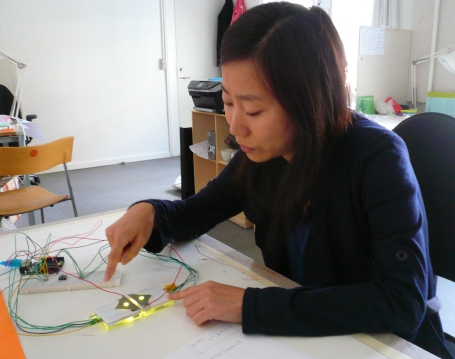Research
The activities I’m carrying on for my research on light and gesture interfaces that evoke the behaviour of a living being and engage our peripheral attention. are mostly on 3 sides:
How the concepts of Instinct, Natural and Innate Perception has been treated in human brain studies and in behaviour/cognitive science? The work of Valentino Braitenberg on synthetic psychology has a peculiar point of view on the topic. Braitenberg in his 1984 book Vehicles, Experiments in Synthetic Psychology presents an armada of simple vehicles that consist only of sensors, motors, and wiring. Despite their simplicity these vehicles show astonishingly diverse behaviours. Braitenberg shows how a simple neural architecture (the wiring) can produce complex behaviours in real world environments. The relationship between robot/robot, robot/environment and robot/human is called in sociology “spurious”, it looks like the robots are connected one to the other and respond with an adaptive behaviour, instead the real cause of what they are doing is in an other dimension that can not be perceived by the scene observer.
So why do we ascribe consciousness to something that is inanimate? The answer is probably in the way human brain works. In his 2003 book L’immagine del mondo nella testa Braitenberg explains that the relationship me/you is already written is our neural network: brains are symmetrical to better understand other symmetrical objects, for instance someone else face. It is crucial for survival to recognise immediately an other conscious being and understand if it is harmful or not.

Besides scanning the environment looking for potential enemies, the brain keeps on anticipate the reason why events happen and builds up findings (plastic synapses), it is also extremely exited if there are coloured and moving signals in the optic field, everything to preserve the species existence. Human beings attention is therefore challenged to be deep focused on something most of the time.
In contemporary environments how can we design devices that engage both the center and the periphery of our attention, to avoid information overload and consequently keep the levels of stress and frustration low? Using Mark Weiser’s words, how can we design calm technology?
An answer can be found in the research of Mihaly Csiksentmihalyi. He defines the concept of flow as an area in between the feeling of boredom and anxiety. The aim of a more intuitive interface is to move the task from being cause of anxiety into the flow area. In this way it should be possible to create a better balance between the user skills and the challenge they have to face to complete an activity and enjoy it.
Along with the theoretical research, I conducted 2 series of user tests to understand if it is possible to create a more intuitive interface using a simple light behaviour routine.
Light can be a rich and meaningful tool to express behaviours through colours, brightness, shapes and speed of changing patterns. Using a recognisable pattern is already a way to deliver content, because disposition is equal to information (e.g. Morse code). Can we therefore design a basic light behaviour grammar?
I conducted 2 rounds of tests on the Dubmate prototypes. Dubmate is a portable device, basically an evolution of the traditional USB stick, designed to share files through a tangible user interface, avoiding the use of computers. The interface is based on the use of gesture and lights/colours.

I designed the first behaviour routine according to my way of imagining the different states of the device. In the second test session, instead, the light behaviour is completely based on the feedback collected during the first round of tests.
These tests allow me to think that is possible to create a common light language that can be largely understood, in fact people have a clear idea on what is easier for them and why (even if there are different opinions on the same behaviour). The users can connect pretty easily light behaviours to meanings and states.
Light can therefore be a powerful tool to show something that is concrete but intangible, therefore invisible (”Physical is the new digital”).
Products, IxD projects, movies showing an interesting use of light/sound/shape/vibration as feedbacks that engage our peripheral attention.